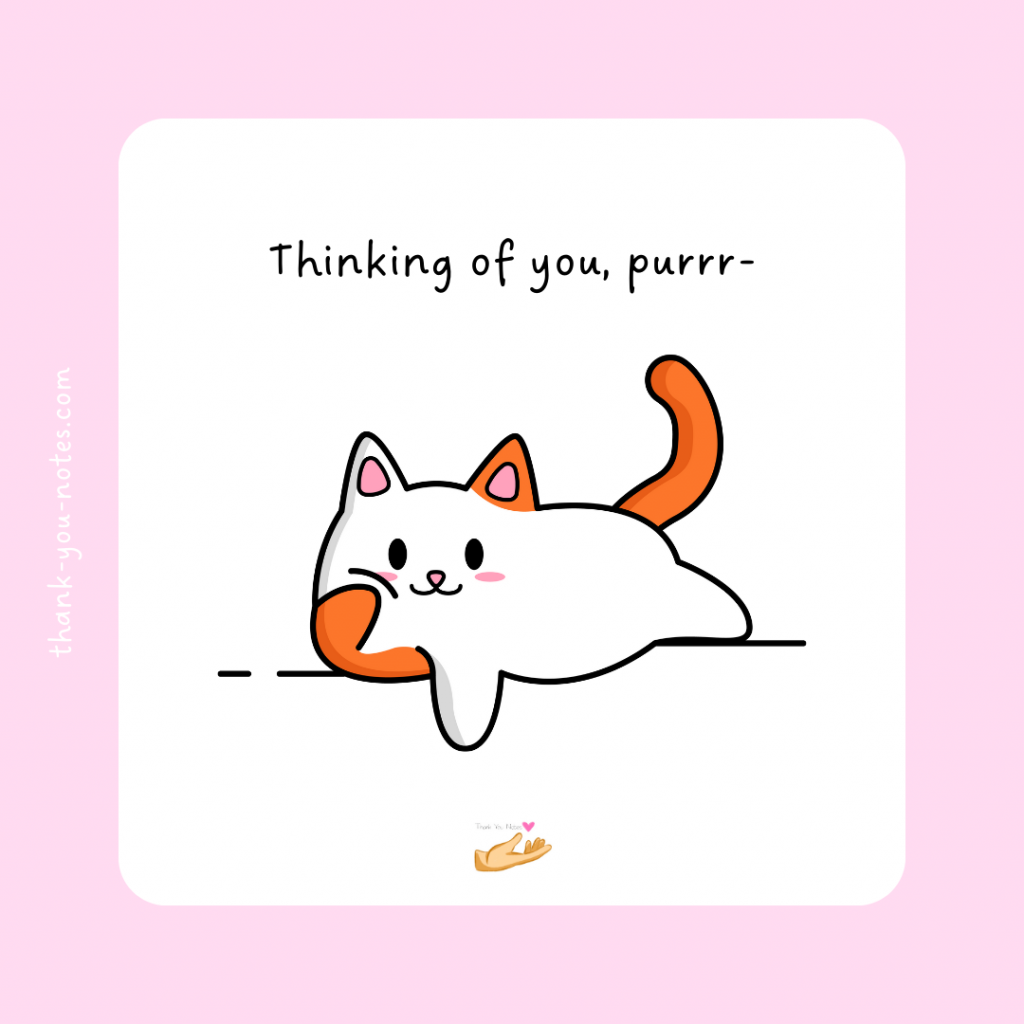The cute cat thank you meme is a compilation of adorable cats’ images with sweet messages for your friends, siblings, family, and even loved ones. These meme compilations will surely make you smile. Read below to know more.
Cats can brighten your day with their doe-like eyes and soft fur. Owning a cat can be a rewarding experience. They calm your nervous system and let you play and cuddle with them. However, they are independent animals but can be your best friend. They usually love to curl up on your lap or shoulders while you are working or reading a book.
Whenever you reward your cats, they say thank you in various ways. They have so many things to be thankful for. The common sign of being thankful is – they rub their head against you. Sometimes, they will lick you to show gratitude.
In this article, we have created a list of cat thank you memes that you can share with your friends and family and have fun with!

100 Fun Facts About Cats: Cat Thank You Meme
Before we bring you the absolutely cute cat thank you memes, we would like to share 100 amazing facts about our cutest feline friends(yes, literally a hundred facts, one can never have enough cat facts!)
You can include some of these when you send these memes to your friends! We all love an interesting cat fact, after all!
- Cats have been domesticated for over 4,000 years, making them one of the oldest known pets.
- The average cat sleeps for around 12-16 hours a day, conserving their energy for bursts of activity.
- Cats have five toes on their front paws and four toes on their back paws, with some cats having extra toes, a condition called polydactyly.
- The world’s oldest cat lived to be 38 years and 3 days old, according to the Guinness World Records.
- Cats have a specialized collarbone that allows them to always land on their feet when they fall, a reflex known as the “righting reflex.”
- A group of cats is called a clowder.
- Cats have a unique grooming behavior known as “allogrooming,” where they groom other cats as a sign of social bonding.
- The frequency of a domestic cat’s purring ranges between 25 and 150 Hertz, which is believed to have a therapeutic effect on humans.
- Cats have a specialized reflective layer behind their retinas called the tapetum lucidum, which enhances their night vision.
- The world’s largest population of domestic cats resides in the United States, with an estimated 74 million pet cats.
- A cat’s nose print is unique, much like a human’s fingerprint.
- Cats have a specialized organ called the Jacobson’s organ located on the roof of their mouth, which allows them to “taste” smells.
- Cats have a strong aversion to water due to their dense fur, which takes a long time to dry.
- The average cat can jump up to six times its body length in a single bound.
- Cats have a keen sense of hearing and can detect frequencies up to 64,000 Hz, much higher than humans.
- The world’s largest cat measured 48.5 inches long from nose to tail and weighed over 46 pounds.
- Cats have retractable claws that they can extend when needed for climbing, hunting, or self-defense.
- The longest whiskers on a cat measured over 7.5 inches long.
- Cats have a specialized tongue covered in tiny, backward-facing barbs called papillae, which help them groom efficiently and assist in capturing prey.
- The average cat can run at speeds up to 30 miles per hour (48 km/h).
- Cats have an excellent sense of balance, thanks to their inner ear and a specialized organ called the vestibular apparatus.
- Cats have a third eyelid called the haw, which helps protect their eyes from damage.
- The world’s oldest recorded cat to give birth was 30 years old.
- Cats have a highly developed sense of smell and can detect scents up to 14 times better than humans.
- Contrary to popular belief, cats are not actually lactose intolerant; however, some cats may develop an intolerance to lactose as they mature.
- Cats have a specialized jaw that allows them to only move their lower jaw up and down, unlike humans, who can move their jaws from side to side.
- Cats have five basic taste receptors, including sweet, sour, salty, bitter, and umami(lol).
- Cats have a unique vocalization known as “chirping,” which they use when observing prey or expressing excitement.
- Cats have a highly flexible spine that allows them to squeeze through small openings and maneuver with agility.
- Cats have a specialized grooming behavior where they lick their fur to remove dirt and distribute natural oils, which helps keep their coat clean and shiny.
- The average cat has 244 bones in its body, while humans have 206.
- Cats have a specialized hunting behavior called “stalking,” where they carefully observe their prey and then pounce with precision.
- Cats have a keen sense of time and can anticipate regular daily routines, such as meal times or when their owners return home.
- The oldest known pet cemetery is located in Egypt and dates back over 9,000 years, where cats were often buried alongside their owners.
- Cats have a highly sensitive sense of touch, with receptors located in their paws, whiskers, and other parts of their body.
- Cats have an average of 12 whiskers on each side of their face, arranged in specific patterns that help them navigate their surroundings.
- The largest cat litter ever recorded consisted of 19 kittens born to a Burmese/Siamese cat in the UK in 1970.
- Cats have a unique ability to rotate their ears independently, allowing them to pinpoint the source of sounds with great accuracy.
- The world’s oldest cat breed is believed to be the Egyptian Mau, which traces its ancestry back to ancient Egypt.
- Cats have a specialized digestive system that allows them to digest bones, fur, and other tough materials from their prey.
- The average cat has a total of 24 whiskers, with 12 on each side of their face.
- Cats have a heightened sense of hearing, which allows them to detect ultrasonic sounds that are inaudible to humans.
- Cats have a specialized structure in their eyes called the tapetum lucidum, which reflects light and enhances their night vision.
- Cats have a highly developed sense of balance, which allows them to walk along narrow ledges and climb trees with ease.
- The world’s largest cat measured 48.5 inches long from nose to tail and weighed over 46 pounds.
- Cats have a strong sense of territory and will often mark their territory with scent glands located on their face, paws, and tail.
- The smallest cat on record was named Tinker Toy, measuring only 2.75 inches tall and 7.5 inches long.
- Cats have a specialized grooming behavior called “bunting,” where they rub their face and body against objects or people to mark them with their scent.
- Cats have a highly flexible spine that allows them to twist and turn their bodies in mid-air to land on their feet.
- The world’s largest cat measured 48.5 inches long from nose to tail and weighed over 46 pounds.
- Cats have a unique behavior known as “kneading,” where they push their paws in and out against a soft surface, often accompanied by purring.
- Cats have a specialized grooming behavior where they use their tongues to clean their fur, removing loose hair, and keeping their coat in good condition.
- Cats have a specialized hunting behavior called “ambushing,” where they hide and wait for their prey to come within striking distance.
- The average cat has 18 toes, with five toes on their front paws and four toes on their back paws.
- Cats have a specialized muscle called the pounce muscle, which allows them to leap and catch their prey with precision.
- Cats have a highly acute sense of hearing and can detect ultrasonic sounds up to 65,000 Hz.
- Cats have a unique vocalization known as “chattering,” which they use when observing birds or other prey outside the window.
- Cats have a specialized reflective layer behind their retinas called the tapetum lucidum, which enhances their night vision.
- The average cat can make over 100 different sounds, including meows, purrs, hisses, and chirps.
- Cats have a specialized hunting behavior called “stalking,” where they carefully observe their prey and then pounce with precision.
- Cats have a highly flexible spine that allows them to squeeze through narrow openings and navigate tight spaces.
- Cats have a specialized grooming behavior called “tongue baths,” where they use their rough tongues to clean their fur and remove dirt.
- Cats have a specialized jaw structure that allows them to only move their lower jaw up and down, unlike humans, who can move their jaws from side to side.
- Cats have a unique ability to rotate their ears independently, allowing them to locate the source of sounds with great accuracy.
- Cats have a specialized scent gland located on the roof of their mouth called the vomeronasal organ, which helps them analyze scents.
- Cats have a highly developed sense of balance, thanks to their inner ear and a specialized organ called the vestibular apparatus.
- Cats have a unique hunting behavior called “chirping,” where they make high-pitched sounds to imitate the sounds of birds or other prey.
- Cats have a specialized grooming behavior called “allogrooming,” where they groom other cats as a sign of social bonding.
- Cats have a highly sensitive sense of touch, with receptors located in their paws, whiskers, and other parts of their body.
- Cats have a keen sense of smell and can detect scents up to 14 times better than humans.
- Cats have a specialized reflective layer behind their retinas called the tapetum lucidum, which enhances their night vision.
- Cats have a unique vocalization known as “trilling,” a mixture of purring and meowing, used to communicate with their owners.
- Cats have a specialized grooming behavior where they lick their fur to remove dirt and distribute natural oils, which helps keep their coat clean and shiny.
- Cats have a keen sense of hearing and can detect frequencies up to 64,000 Hz, much higher than humans.
- Cats have a specialized organ called the Jacobson’s organ located on the roof of their mouth, which allows them to “taste” smells.
- Cats have a strong aversion to water due to their dense fur, which takes a long time to dry.
- The average cat can jump up to six times its body length in a single bound.
- Cats have a specialized hunting behavior called “stalking,” where they carefully observe their prey and then pounce with precision.
- Cats have a highly developed sense of hearing and can detect frequencies up to 64,000 Hz, much higher than humans.
- The world’s largest cat measured 48.5 inches long from nose to tail and weighed over 46 pounds.
- Cats have retractable claws that they can extend when needed for climbing, hunting, or self-defense.
- The longest whiskers on a cat measured over 7.5 inches long.
- Cats have a specialized tongue covered in tiny, backward-facing barbs called papillae, which help them groom efficiently and assist in capturing prey.
- The average cat can run at speeds up to 30 miles per hour (48 km/h).
- Cats have an excellent sense of balance, thanks to their inner ear and a specialized organ called the vestibular apparatus.
- Cats have a third eyelid called the haw, which helps protect their eyes from damage.
- The world’s oldest recorded cat to give birth was 30 years old.
- Cats have a highly developed sense of smell and can detect scents up to 14 times better than humans.
- Contrary to popular belief, cats are not actually lactose intolerant; however, some cats may develop an intolerance to lactose as they mature.
- Cats have a specialized jaw that allows them to only move their lower jaw up and down, unlike humans, who can move their jaws from side to side.
- Cats have five basic taste receptors including sweet, sour, salty, bitter, and umami.
- Cats have a unique vocalization known as “chirping,” which they use when observing prey or expressing excitement.
- Cats have a highly flexible spine that allows them to squeeze through small openings and maneuver with agility.
- Cats have a specialized grooming behavior where they use their tongues to clean their fur, removing loose hair, and keeping their coat in good condition.
- Cats have a specialized hunting behavior called “ambushing,” where they hide and wait for their prey to come within striking distance.
- The average cat has 18 toes, with five toes on their front paws and four toes on their back paws.
- Cats have a specialized muscle called the pounce muscle, which allows them to leap and catch their prey with precision.
- Cats have a highly acute sense of hearing and can detect ultrasonic sounds up to 65,000 Hz.
- Cats have a unique behavior known as “kneading,” where they push their paws in and out against a soft surface, often accompanied by purring.
- Cats have a specialized grooming behavior which they take really seriously! Cats are extremely clean animals. Our felines friends take cleanliness very seriously!
20 Cat Thank You Meme You’ll Love
Who doesn’t love a cute little cat meme? Literally no one! Send these heartwarming and cute cat thank you memes to your loved ones and make their days a bit brighter!
Find your favorites below from these 20 headings for cute cat thank you memes:
Purr-fectly Thankful

You’re the Cat’s Meow
Grateful Feline

Sending Catitude

Furry Appreciation

You’re Pawsome

Whisker Kisses

Feline Thanks

Cat-tastic Gratitude

Pawsitively Thankful

Kitty Hugs

Meow-sive Gratitude

Cute Cat Thanks

Purr-fect Appreciation

Feline Gratitude

Cat Nap Thanks

Pawsitive Vibes

Thankful Whiskers

Purr-sonal Thanks

Cat-titude of Gratitude

Conclusion
The popularity of cat memes is undeniable, and their charm knows no bounds. By incorporating the element of gratitude, these memes take on an even more endearing and meaningful role. They capture the essence of our feline companions’ lovable nature and the joy they bring to our lives. Sharing these memes not only spreads positivity and happiness but also strengthens the bonds between individuals.
You will love the cat thank you meme compilation if you are a cat owner. One of the great benefits of having a cat is you do not need a huge space to play with them. There are various breeds of cats you can adopt, and they can fit anywhere – basket, box, even bowls. All you have to do is groom and feed your cats properly; they will love you more than anyone in the world. Also, the way they treat you will make you feel more grateful toward yourself.
